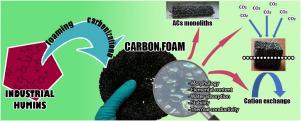Applied Materials Today ( IF 7.2 ) Pub Date : 2020-06-02 , DOI: 10.1016/j.apmt.2020.100622 Pierluigi Tosi , Gerard P.M. van Klink , Charlotte Hurel , Claire Lomenech , Alain Celzard , Vanessa Fierro , Clara Delgado-Sanchez , Alice Mija

|
Humins as biorefineries by-product can be converted with a direct heating treatment into new rigid porous carbon materials known as humins foams. Currently, not many informations about this new material are known. Here, a preparation protocol in two steps involving foaming and carbonization is reported, while the materials have been investigated in terms of morphology, elemental content, water adsorption–desorption, stability to solvents and high temperatures, and thermal conductivity. In order to evaluate their potential uses in applications such as water purification, the pH associated to the zero charge point has been identified. Foams prepared under air ventilated condition revealed an extremely negative surface, which can be used in cation exchange applications. The surface's groups have been identified by Boehm titration, showing that this behavior can be associated to the presence of acid moieties, while the basic species result absent. The humins foams have been also tested through CO2 adsorption tests at realistic operation conditions, revealing that their performances can compete with materials reported in literature. Finally, activated carbon monoliths from carbonized humins foams using CO2 activation were tested, reaching a surface area of 1347 m2 g−1 after 20 min and 1482 m2 g−1 after 40 min of activation. These monoliths have been characterized in terms of morphology and elemental content. The results prove that the humins foams are very versatile materials, cost effective and easy to produce, with promising properties that can be further tailored for foreseen applications.
中文翻译:

研究腐殖质泡沫的特性,腐殖质泡沫是生物精炼副产物衍生的多孔碳质材料
腐殖质作为生物精炼厂的副产品,可通过直接加热处理将其转化为新型的刚性多孔碳材料,称为腐殖质泡沫。当前,关于这种新材料的信息并不多。在此,据报道,制备步骤分为两个步骤,涉及发泡和碳化,同时对材料进行了形态,元素含量,水吸附-解吸,对溶剂和高温的稳定性以及导热性方面的研究。为了评估其在水净化等应用中的潜在用途,已确定了与零电荷点相关的pH。在通风条件下制备的泡沫具有极负的表面,可用于阳离子交换应用。通过Boehm滴定确定了表面的基团,表明这种行为可能与酸部分的存在有关,而碱性物质则不存在。腐殖质泡沫也通过了CO测试在实际操作条件下进行的2次吸附测试表明,它们的性能可以与文献中报道的材料相媲美。最后,测试了使用CO 2活化的碳化人石泡沫中的活性炭整料,活化20分钟后表面积达到1347 m 2 g -1,活化40分钟后达到表面积1482 m 2 g -1。这些整料已经根据形态和元素含量进行了表征。结果证明,胡敏泡沫材料是非常通用的材料,具有成本效益且易于生产,并具有可以针对预期应用进一步定制的有前途的性能。











































 京公网安备 11010802027423号
京公网安备 11010802027423号